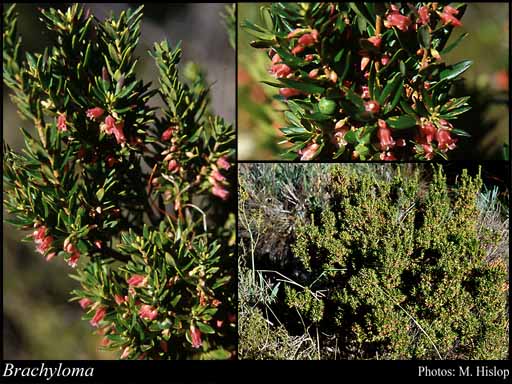- Reference
- Pl.Preiss. [J.G.C.Lehmann] 1(4):304 (1845)
- Name Status
- Current

Scientific Description
Family Epacridaceae.
Habit and leaf form. Shrubs; evergreen; leptocaul, or pachycaul. Helophytic to xerophytic. Leaves minute to medium-sized; alternate; spiral, or four-ranked; ‘herbaceous’, or leathery; imbricate, or not imbricate; petiolate; non-sheathing; simple. Leaf blades entire; flat, or rolled; palmately veined; cross-venulate, or without cross-venules. Leaves without stipules. Leaf blade margins flat, or revolute. Stem anatomy. Nodes unilacunar. Secondary thickening developing from a conventional cambial ring.
Reproductive type, pollination. Fertile flowers hermaphrodite. Unisexual flowers absent. Plants hermaphrodite. Entomophilous, or ornithophilous. Pollination mechanism unspecialized.
Inflorescence and flower features. Flowers solitary; axillary (on short peduncles); shortly pedicellate; bracteate, or ebracteate. Bracts persistent (and small), or deciduous. Flowers bi- bracteolate; small; fragrant, or odourless; regular; 5 merous; cyclic; tetracyclic. Free hypanthium absent. Hypogynous disk present; intrastaminal; annular (with lobed or toothed upper margin). Perianth with distinct calyx and corolla; 10; 2 -whorled; isomerous. Calyx 5; 1 -whorled; polysepalous; imbricate; regular; persistent. Corolla 5; 1 -whorled; gamopetalous; lobed (lobes spreading, obtuse or acute). Corolla lobes about the same length as the tube. Corolla imbricate; tubular (tube short); regular; hairy adaxially (with tufts of hairs or ciliate scales reflexed in the throat at the base of the lobes; lobes glabrous inside and out); white, or cream, or yellow to orange, or red, or pink; persistent, or deciduous. Androecium 5. Androecial members adnate (to the corolla); all equal; free of one another; 1 -whorled. Androecium exclusively of fertile stamens. Stamens 5. Staminal insertion in the throat of the corolla tube. Stamens remaining included, or becoming exserted (partially); isomerous with the perianth; oppositisepalous; all alternating with the corolla members. Filaments glabrous; short. Anthers attached above the middle; becoming inverted during development, their morphological bases ostensibly apical in the mature stamens; non-versatile; dehiscing via longitudinal slits (by a single median slit); finally introrse (inverting during development); unilocular; bisporangiate; unappendaged. Pollen shed in aggregates; without viscin strands; in tetrads. Gynoecium 4–5 carpelled. The pistil 4–5 celled. Gynoecium syncarpous; eu-syncarpous; superior. Ovary plurilocular; 4–5 locular (or more in B. scortechinii). Gynoecium stylate. Styles 1; short, cylindrical; attenuate from the ovary; apical. Stigmas 1; lobed; small, truncate, or clavate, or capitate. Placentation apical. Ovules 1 per locule; pendulous; non-arillate; anatropous.
Fruit and seed features. Fruit fleshy (mesocarp pulpy); indehiscent; a drupe. The drupes with one stone. Seeds endospermic. Endosperm oily. Seeds wingless. Embryo well differentiated. Cotyledons 2. Embryo straight. Seedling. Germination phanerocotylar.
Physiology, biochemistry. Aluminium accumulation not found. Photosynthetic pathway: C3.
Geography, cytology, number of species. Native of Australia. Endemic to Australia. Australian states and territories: Western Australia, South Australia, Queensland, New South Wales, Victoria, and Tasmania. South-West Botanical Province.
Additional characters Prophylls few.